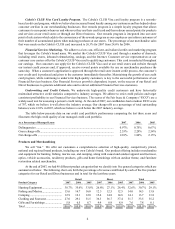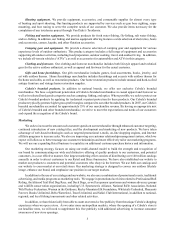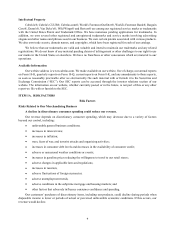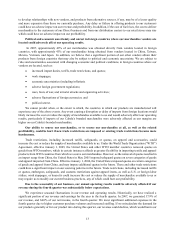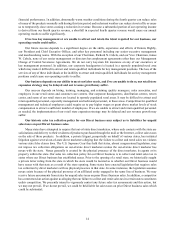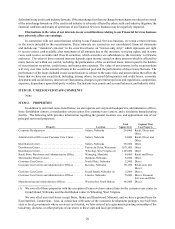Cabela's 2007 Annual Report Download - page 16
Download and view the complete annual report
Please find page 16 of the 2007 Cabela's annual report below. You can navigate through the pages in the report by either clicking on the pages listed below, or by using the keyword search tool below to find specific information within the annual report.10
Competition in the outdoor recreation and casual apparel and footwear markets could reduce our revenue
and profitability.
The outdoor recreation and casual apparel and footwear markets are highly fragmented and competitive. We
compete directly or indirectly with the following types of companies:
• other specialty retailers that compete with us across a significant portion of our merchandising categories
through retail store or direct businesses, such as Bass Pro Shops, Gander Mountain, Orvis, The Sportsman's
Guide, and Sportsman's Warehouse;
• large-format sporting goods stores and chains, such as The Sports Authority, Dick's Sporting Goods, and
Big 5 Sporting Goods;
• retailers that currently compete with us through retail businesses that may enter the direct business;
• mass merchandisers, warehouse clubs, discount stores, and department stores, such as Wal-Mart and
Target; and
• casual outdoor apparel and footwear retailers, such as L.L. Bean, Lands’ End, and REI.
Many of our competitors have a larger number of stores, and some of them have substantially greater market
presence, name recognition, and financial, distribution, marketing, and other resources than we have. In addition, if
our competitors reduce their prices, we may have to reduce our prices in order to compete. Furthermore, some of our
competitors have been aggressively building new stores in locations with high concentrations of our Direct business
customers. As a result of this competition, we may need to spend more on advertising and promotion. Some of our
mass merchandising competitors, such as Wal-Mart, do not currently compete in many of the product lines we offer.
If these competitors were to begin offering a broader array of competing products, or if any of the other factors listed
above occurred, our revenue could be reduced or our costs could be increased, resulting in reduced profitability.
If we fail to maintain the strength and value of our brand, our revenue is likely to decline.
Our success depends on the value and strength of the Cabela’s brand. The Cabela’s name is integral to our
business as well as to the implementation of our strategies for expanding our business. Maintaining, promoting,
and positioning our brand will depend largely on the success of our marketing and merchandising efforts and our
ability to provide high quality merchandise and a consistent, high quality customer experience. Our brand could be
adversely affected if we fail to achieve these objectives or if our public image or reputation were to be tarnished by
negative publicity. Any of these events could result in decreases in revenue.
If we cannot successfully implement our retail store expansion strategy, our growth and profitability
would be adversely impacted.
We continue to actively seek additional locations to open new retail stores. Our ability to open new retail
stores in a timely manner and operate them profitably depends on a number of factors, many of which are beyond
our control, including:
• our ability to manage the financial and operational aspects of our retail growth strategy;
• our ability to identify suitable locations, including our ability to gather and assess demographic and
marketing data to determine consumer demand for our products in the locations we select;
• our ability to negotiate and obtain economic development packages with local and state governments
where our new retail stores would be located;
• our ability to properly assess the implications of economic development packages and customer density
to project the profitability of potential new retail store locations;
• our ability to secure required governmental permits and approvals;
• our ability to hire and train skilled store operating personnel, especially management personnel;
• the availability of construction materials and labor and the absence of significant construction delays or
cost overruns;






